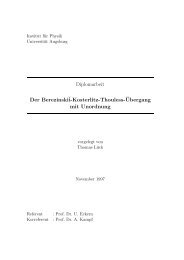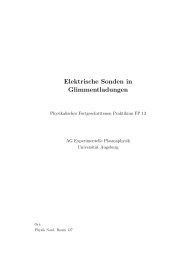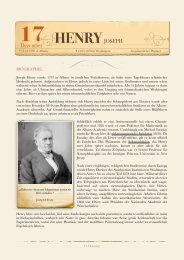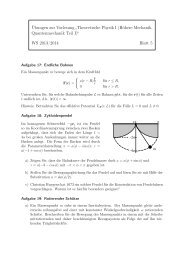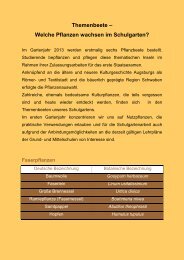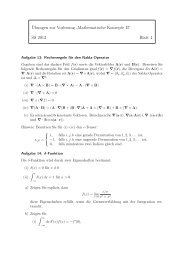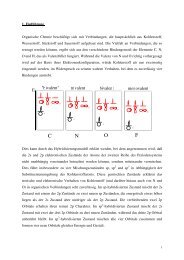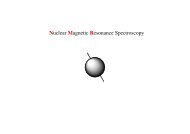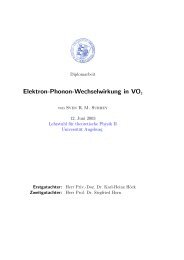Driven Quantum Systems - Institut für Physik
Driven Quantum Systems - Institut für Physik
Driven Quantum Systems - Institut für Physik
You also want an ePaper? Increase the reach of your titles
YUMPU automatically turns print PDFs into web optimized ePapers that Google loves.
284 <strong>Driven</strong> <strong>Quantum</strong> <strong>Systems</strong><br />
interaction is switched off. Consistent quantitative treatments of dissipation for driven<br />
quantum systems are difficult, but represent a challenging area of timely research. First<br />
interesting accomplishments have been put forward recently in Ref. [48]. Strong driving<br />
and moderate-to-strong dissipation are of particular importance for the intriguing<br />
phenomenon of nonlinear <strong>Quantum</strong> Stochastic Resonance [49]. Also, we have mainly<br />
addressed the driven dynamics in the deep quantum regime. Characteristic for driven<br />
quantum systems is that these exhibit a chaotic dynamics in the classical limit. For the<br />
phenomena occurring near the border line between quantum and classical dynamics,<br />
where a full semiclassical description is appropriate, the reader is refered to chapter 6<br />
on quantum chaos. With driven quantum systems containing a rich repertory for novel<br />
phenomena, and providing us with the tool to control selectively the quantum dynamics,<br />
we hope that the readers become invigorated to extend and enrich the physics of<br />
strongly driven quantum systems with own original contributions.<br />
References<br />
[1] N. L. Manakov, V. D. Ovsiannikov, and L. P. Rapoport, Phys. Rep. 141, 319<br />
(1986).<br />
[2] S.-I. Chu, Adv. Chem. Phys. 73, 739 (1986).<br />
[3] G. Casati and L. Molinari, Progr. Theor. Phys. Suppl. 98, 287 (1989).<br />
[4] A. G. Fainshtein, N. L. Manakov, V. D. Ovsiannikov, and L. P. Rapoport,<br />
Phys. Rep. 210, 111 (1992).<br />
[5] H. R. Reiss, Phys. Rev. Lett. 25, 1149 (1970).<br />
[6] M. Gavrila and J. Z. Kaminski, Phys. Rev. 52, 613 (1984);<br />
Q.SuandJ.H.Eberly,Phys.Rev.A44, 5997 (1991);<br />
F. Bensch, H. J. Korsch and N. Moiseyev, Phys. Rev. A 43, 5145 (1991);<br />
H. Wiedemann, J. Mostowski, and F. Haake, Phys. Rev. A 49, 1171 (1994).<br />
[7] For reviews see:<br />
G. Casati, I. Guarneri, D. L. Shepelyansky, IEEE J. Quant. Elect. 24, 1420 (1988);<br />
R. Shakeshaft, Comments At. Mol. Phys. 28, 179 (1992);<br />
Laser Phys. 3, No. 2 (1993), special issue on Atoms, Ions and Molecules in a<br />
Strong Laser Field, editedbyA.M.Prokhorov.<br />
[8] D. J. Tannor and S. A. Rice, Adv. Chem. Phys. 70, 441 (1988);<br />
P. Brumer and M. Shapiro, Ann. Rev. Phys. Chem. 43, 257 (1992);<br />
D. J. Tannor, in: Molecules and Laser Fields, editedbyA.D.Bardrak,(Dekker,<br />
1993), pp. 403 - 446.<br />
[9] F. Grossmann, T. Dittrich, P. Jung and P. Hänggi, Phys. Rev. Lett. 67, 516<br />
(1991);<br />
for a review see: P. Hänggi, Control of Tunneling, in: <strong>Quantum</strong> Dynamics of<br />
Submicron Structures, edited by H. A. Cerdeira, B. Kramer and G. Schön, Vol. 291



